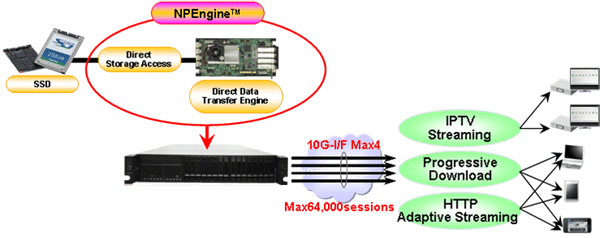 Toshiba announced a new SSD to IP hardware engine called NPEngine, which is aimed to deliver video content off flash storage without requiring server CPU or memory. NPEngine is capable of delivering up to 64,000 streams simultaneously at rates up to 40Gb/s, which is well above the abilities of a standard server, at a fraction of the resources needed.
Toshiba announced a new SSD to IP hardware engine called NPEngine, which is aimed to deliver video content off flash storage without requiring server CPU or memory. NPEngine is capable of delivering up to 64,000 streams simultaneously at rates up to 40Gb/s, which is well above the abilities of a standard server, at a fraction of the resources needed.
Toshiba announced a new SSD to IP hardware engine called NPEngine, which is aimed to deliver video content off flash storage without requiring server CPU or memory. NPEngine is capable of delivering up to 64,000 streams simultaneously at rates up to 40Gb/s, which is well above the abilities of a standard server, at a fraction of the resources needed.
With the expansion of devices capable of streaming network video expanding on a near exponential status, devices like smart phones, tablets, and PC’s continuously grow the resources needed to feed media-hungry consumers. Current video-serving platforms are resource intensive, requiring substantial amounts of system resources like CPU and RAM, limiting a standard 2RU server to roughly 20,000 streams. To support more streams, under the existing model, companies would have to add additional servers, requiring more costly resources such as power and physical space in the datacenter.

Toshiba’s NPEngine offers a new solution, removing the CPU and RAM needs of streaming video content and offloads it onto a dedicated hardware engine. By delivering up to 64,000 streams, this new solution more than triples existing capabilities, while cutting power requirements by 77% and rackspace requirements by 70% in server arrays to able to deliver upwards of 1,000,000 streams.
Toshiba has stated that server products running NPEngine will be available later this year, with systems showcasing this performance being displayed at upcoming shows.
